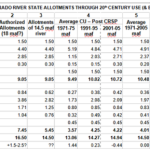
‘The single biggest roadblock to solving the problem of stabilizing the river is the priority system.’
– Tom Buschatzke, Director of Arizona’s Department of Water Resource
Last post, I laid out some reasons why the water mavens now engaged in mapping out Colorado River management strategies beyond 2026 – the year ‘interim’ management strategies expire – should consider laying the Colorado River Compact to rest, archiving it along with most of the chain of subsequent compacts, rules and guidelines, legislated acts, minuted treaties and interim patches and props known as the ‘Law of the River,’ and start over with a new compact that actually reflects contemporary river realities.
One of those reasons was the fact that the Compact had failed from the start in its primary goal: to provide for an ‘equitable division and apportionment of the use of the waters’ that was not driven by the prior appropriation doctrine, which was leading the seven states into an appropriation ‘horse race’ in which California was already lapping the other six states.
Over the past years we have heard again and again, in speech and in print, that the Colorado River Compact is the ‘foundation of the Law of the River.’ That is just not true. The foundational law of all the law governing use of the river is the doctrine of prior appropriation, which all seven of the compact states had adopted from the time they were territories, as a vehicle for the reasonably orderly distribution of essential water among water users in the arid and semi-arid lands.
That is what we’re going to look into today – the doctrine of prior appropriation that is the foundation on which the formal and informal management of the river is built. (Fools tiptoe in where mavens fear to tread.)
The appropriation doctrine for the use of water in arid regions evolved literally everywhere at once in the arid West, a grassroots ‘common law’ that was only formalized, not created, when states wrote it into their laws and constitutions. ‘Common law’ refers to the ‘justice’ that people agree upon in resolving problems among themselves before there are local governments with sheriffs and judges to apply justice for them.
An appropriator of water could be anyone from an individual to a whole ditch company organized in a number of ways. An appropriation of water was created by just digging a ditch from a stream to put some water to use, and if you were smart posting a dated notice near it and starting a ditch journal at home. But no one needed to be asked for permission, and evidence of actual use amounted to proof of appropriation. ‘The right to divert the unappropriated waters of any natural stream to beneficial uses shall never be denied,’ the Colorado Constitution says.
But as more people came to use the streams, priority of appropriation became an issue that had to be resolved between parties wanting to use the same water in the pre-law period. That was probably resolved reasonably amicably in many cases; but for the rugged American individualist yeomen invented by Thomas Jefferson and John Locke, it could get tense, even violent; and the common rule arrived at among the unruled, when neither side would yield, was that the first user had the better claim, and got his water first, with the subsequent users in ranked priority for what was left. Once county and state offices were set up, land and water appropriation claims could be officially filed, with law enforcement to back them, which made it all easier, but still it occasionally resulted in open competitive conflict, in a nation of rugged individualists.
Appropriation law has developed a reputation today of being terribly complex, but it is all founded on that simple default premise, easily understood even by children on the playground: first come, first served. Although it should be acknowledged that the appropriation and privatization of water from the commons is not a universally accepted ‘God-given’ practice.
It should also be noted that a sociopolitical philosophy underlay appropriation law as it first evolved in the arid lands. The ‘agrarians’ – farmers and would-be farmers in counterrevolutionary retreat from the dominant Industrial Revolution back in the states – wanted to protect themselves from the speculators scouring the continent for investment opportunities for private capital. So their law insisted that no one could appropriate more water than he or she could put directly to use (or show ‘due diligence’ in installing the works to put the water to use). This prevented speculators from appropriating whole streams, to profit from selling or leasing to would-be farmers.
The emerging law also said that no riparian users could keep subsequent appropriators from access to the stream, even if it meant letting a junior user run a ditch through their fields. While appropriation was oriented toward the individual, this condition encouraged collaboration among users on a stream: the first user’s ‘mother ditch’ could be enlarged to carry water to other farms rather than cutting through the first users’ fields. My great grandfather James Short and his brother Frank started a floodplain ditch in the valley of the North Fork of the Gunnison River that, by the time they filed for a water right in 1889, had 21 farmers using the enlarged ‘Short Ditch,’ all named in the decree.
The Short brothers did not create a formal ‘ditch company’ for their often-enlarged ditch, but when it came to settling the mesas and benches above the floodplains, requiring long expensive upstream conveyance ditches, ditch companies were almost necessary, formally registered companies with a large appropriation shared out among the funding members once the system was completed. Entrepreneurs also somehow skirted the speculation issue, purchasing dry uplands at a low price and running a long conveyance ditch to it in order to resell it as irrigated land. Incorporated and unincorporated communities appropriated water for domestic and industrial purposes – the City of Gunnison went from a sagebrush flat to a ‘Tree City’ designation, thanks to a municipal ditch system along its streets.
For those interested in the agrarian roots of the prior appropriations doctrine, an excellent book on the subject is The Colorado Doctrine: Water Rights, Corporations, and Distributive Justice on the American Frontier by legal scholar David Schorr. It is all very straightforward, if not all as simple as the basic premise.
Complexity began to enter the system as users on the streams increased, and all local streams conflued with other streams, all with water users with rights in priority too; seniority in one watershed was not necessarily seniority in the downstream confluence with several watersheds. Hierarchies of state engineer and water commissioners had to compile all of that inter-watershed information and organize it by priority for entire river basins – eight major basins in Colorado alone. This was a formidable task in the pre-computer era; now we can look up water rights in minutes.
Other complexities emerged, however, that began to change prior appropriation law – essentially a grafting of the urban-industrial mainstream game plans onto its agrarian roots. This complexity would have been precluded, or at least deferred, by a second simple rule proposed by the explorer-scientist Major John Wesley Powell. In his famously ignored 1877 ‘Report on the Lands of the Arid Regions’ – actually a detailed plan for an agrarian West – Powell proposed that, since the land was essentially worthless without the water, the right to use the water should ‘inher’ in the title for the land – land and water bound together as a single property.
His recommendation was ignored everywhere. Instead, land titles and water rights evolved as separate ‘properties.’ The right to just use a quantity of water became a property that could be bought and sold, like a piece of land or an automobile, separate from the land it nourished. And the sold water right kept its place in priority with the new owner; seniority went along with the purchase of the right to use the water.
This freeing of water rights from their original purpose, alone, made the appropriations laws a powerful engine for the growth of great cities. Growing cities, with their concentrated wealth, could grow well beyond the limits of their own local water supply by buying water rights from users many miles distant and bringing the water to the city.
But an incident in two small tributaries of the South Platte River in Colorado’s Front Range led to further complexity – or opportunity, as the western city builders would have seen it. A little water was taken across a ridge from one watershed into another on Colorado’s Front Range. This was contested in water court by users from the basin of origin because they said it limited the future development of their watershed. The court, however, found that insufficient reason to deny this small ‘transbasin diversion.’
But given that foot in the door, the door was pushed open for much larger transbasin diversions – transmountain diversions, even through the Continental Divide, with no legal responsibility on the diverter to compensate the basin of origin for water appropriated or purchased, and the resulting loss of a piece of its future (sine agua nada).
These ‘complexities’ showed up in one form or another in the appropriation laws throughout the arid West. California, as usual, was first to really exploit it, bringing questionably acquired water a hundred miles from the Sierras to the Los Angeles Basin in the first decade of the 20th century. Transmountain diversions have been the cause of most of Colorado’s so-called ‘water wars,’ with the urban-industrial metropolis east of the Continental Divide now taking half a million acre-feet annually from the West Slope’s Colorado River headwaters.
The ‘great and growing cities’ of the eastern plains also managed to undermine, or at least muddy, the appropriation doctrine’s fundamental anti-speculation mandate, to only appropriate as much water as you could put directly to use. In the 1930s Denver leased and lined the pilot bore for the Moffat Tunnel, to move water through the Divide from the Fraser River on the West Slope. In 1937 the city filed for a Fraser water right that was almost twice as much water as they could put to use, planning to lease the rest to East Slope agricultural users until the growing city needed it.
The leaders of the newly created Colorado River Water Conservation District, protecting the West Slope’s water, challenged that additional water as speculation. The district water court judge agreed with them, and reduced the city’s claim accordingly. But Denver appealed the decision to the Colorado Supreme Court – which reversed the district judge’s finding, determining that ‘it is not speculation but the highest prudence on the part of the city to obtain appropriations of water that will satisfy the needs resulting from a normal increase in population within a reasonable period of time.’
The courts have gone back and forth for decades now, trying to pin down what constitutes ‘prudent’ acquisition of water to meet ‘a normal increase in population within a reasonable period of time.’ But the sprawling urban growth throughout the Southwest since World War II has essentially made distinctions between ’normal growth’ and ‘speculation’ meaningless. And most of that growth has depended on water brought in from distant places – some acquired from farmers, for whom water rights constitute a good retirement package.
The mythographers of money like to say that ‘in the West water flows uphill toward money,’ implying an effortless magnetism for money. The truth is that large quantities of money come out from the concentrated wealth of the cities to suck up – at a considerable but affordable cost – the water (as well as other raw resources) to feed the cities’ growth.
One can argue – I might even – that the anti-capitalist appropriations law as conceived by the agrarian ‘counterrevolutionaries’ was at best a holding action that could not forever hold off the juggernaut of the Industrial Revolution rolling across the continent. One can also point out that, despite all this, the farmers still own the rights to 70-80 percent of Colorado River water. But that is mostly just because the urban-industrial juggernaut hasn’t needed more of it, yet; and in any case most of the agriculture in the Colorado River region is pretty thoroughly industrialized agribusiness. (Only in the headwaters tributaries does one still find a hereditary agrarian ‘agri culture’ – and it is feeling besieged.)
Those major ‘complexifications’ of the original simple idea of prior appropriation law probably barely scratch the surface of the ever more complex evolution of the prior appropriation doctrine, an evolution that goes on despite – or maybe because of – the fact that there is really no more water to appropriate from the exhausted commons.
There is, however, one more complexification that needs to be considered, to really understand where things are today in the Colorado River region, and that is the Colorado River Compact itself, and the rationale behind it that failed in trying to go around the appropriation doctrine rather than going through it.
But I’ve gone on long enough on this post; that will be for next time – with some thoughts on how we could maybe sketch out a compact that might work to address some of the challenges we face, now and beyond 2026, that the current Compact can’t resolve. Stay tuned.




Love that cover image, George. This latest piece strikes me as a good description of the problem, some of what created it, and it was understandable even to a Minnesotan whose knowledge of water and water law is pretty minimal. Indeed, it does often seem to be “the tragedy of the commons,” written in water rather than typographer’s ink. Our ancestors ignored Powell’s suggestion at their (and our) peril, but I look forward to the next episode. The current Compact has obviously failed to achieve its purpose, so I’m interested in what the replacement might do, or say, differently.
insightful as always, thanks George
In your first sentence you used the word “maven”, George. You lost me there and I had to look up its definition.
1) Yes, I was born under a rock and
2) Wikipedia should have your picture in there cuz you ARE one. Maybe the supreme one!
You aren’t the only one who’ll have to look that up; I did, just to make sure it was right for what I wanted to say. I’m tired of calling people with some specialized expertise ‘experts’; ‘maven’ has a bit of the feel of ‘magician,’ or ‘mage’ – somebody who is trying to make you believe something that isn’t actually true in the way it’s being presented…. They never really saw in half the person, or the river…. Speaking of ‘experts’ – someone told me once that ‘X’ is the unknown quantity, and a ‘spurt’ is a drip under pressure = ‘expert.’
Very thoughtful analysis! Anxious to learn “the rest of the story” in your next blog!
Very interesting, as always. And aggravating—– at the failure to even consider the ecological realities. ken